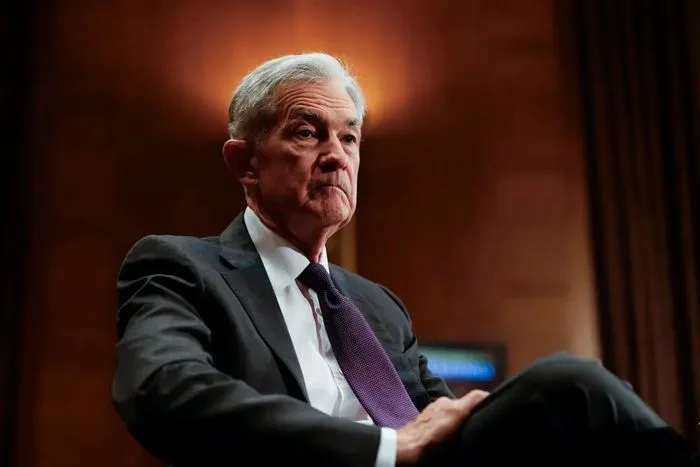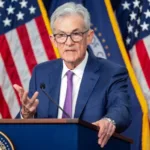By Naveen Athrappully
The Federal Reserve will likely make two interest rate cuts before the end of 2025, Sam Stovall, chief investment strategist at financial services company CFRA Research, said in an Aug. 18 interview with CNBC.
Stovall said that investors will be watching for the Fed’s statements at the Jackson Hole Economic Policy Symposium on Aug. 21–23. If Fed Chair Jerome Powell says that decisions regarding policy rates will be based on economic data, “we’re looking at the possibility of a slowing employment picture while at the same time maintaining a fairly sticky inflation environment,” he said.
According to Stovall, he is expecting year-on-year core personal consumption expenditures, an inflation gauge used by the Fed, to remain at or above 3 percent through 2025.
“And so, that’s a concern that they will have to deal with, but we’re going to be listening quite closely to see whether Fed Chair Powell will be sort of setting us up for a rate cut in September,” he said.
Stovall said that the Fed has to make decisions that are likely to affect the U.S. economy 12 to 18 months down the road.
“So, they don’t want to allow the economy to move along, employment to loosen more dramatically over time without doing anything at all. So, I believe that they feel that they need to cut rates,” he said.
“We think they’ll do it in September, skip October, do it again in December, basically just feeling as if they’re adding a little bit of stimulus while at the same time not fanning the flames of inflation.”
The next Fed policy meeting is scheduled for Sept. 16–17, followed by one each in October and December.
The Fed has kept interest rates unchanged since December at a 4.25 percent to 4.5 percent range for five consecutive meetings, including the most recent one on July 29–30.
In the July 30 press conference following the meeting, Powell cited inflation risks as a cause for lingering concern. The effects of tariffs on inflation and economic activity “remain to be seen,” he said.
While the impact of inflation could be short-lived, there is also a possibility that it could be “more persistent,” the Fed chair said. “And that is a risk to be assessed and managed.”
The central bank’s policy actions are guided by its twin mandate to promote maximum employment and stable prices for Americans, Powell said, adding that the unemployment rate remains low while inflation is somewhat above the 2 percent target.
“We see our current policy stance as appropriate to guard against inflation risks,” he said.
New data regarding labor and inflation since the July meeting has now raised concerns about the Fed retaining rates at the current levels.
On Aug. 1, the Labor Department released its employment report, which showed that the unemployment rate jumped to 4.2 percent in July. Moreover, the department also revised down previous job growth data for May and June.
The Trump administration disputed the employment numbers, with the president firing commissioner Erika McEntarfer from the Bureau of Labor Statistics on Aug. 1, alleging a manipulation of data for political purposes. E.J. Antoni, a chief economist at The Heritage Foundation, has been nominated for the post.
As for inflation, the annual inflation rate remained unchanged at 2.7 percent in July. However, core inflation—which excludes volatile food and energy prices—rose to 3.1 percent.
Rate Cut Tussle
At the Fed’s July meeting, Governors Michelle Bowman and Christopher Waller dissented from the decision to keep rates unchanged. It was the first time since 1993 that two Fed governors dissented.
Bowman said in an Aug. 1 statement that she backed a 25-point cut at the meeting because she sees “the risk that a delay in taking action could result in a deterioration in the labor market and a further slowing in economic growth.”

Waller said the current monetary policy was more restrictive than required, given that inflation is progressing toward the 2 percent target and GDP is slowing down. As for tariffs, the one-off increases in price level should be “looked through,” the governor said.
“When labor markets turn, they often turn fast,” Waller said.
He added that waiting for more clarity on tariffs could leave the central bank “behind the curve.”
Bowman later said on Aug. 9 that recent job data reinforced her concerns about the fragility of the labor market and supports her view of three rate cuts for the year.
President Donald Trump has suggested cutting rates down significantly to between 0.25 and 1.75 percent, similar to nations such as Switzerland and Japan, to trigger growth and bring down borrowing costs.
Powell has maintained that rates would only be cut when the central bank is convinced that inflation would not jump as a result of tariffs. Powell’s term is due to end in May 2026.
Last week, Treasury Secretary Scott Bessent urged the Fed to cut interest rates by half a percentage point in the September meeting and follow it up with additional easing.
Rates should be 150–175 points lower than the current level, he suggested.





